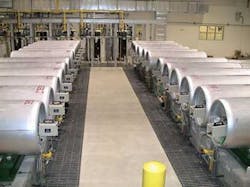System Offers Secure Control of Chlorine Ton Containers
by Michael Koenig and Gary Slaydon
Like most municipalities, Omaha’s Metropolitan Utilities District has used chlorine to disinfect the public’s potable water for many of its 118 years in operation. Chlorine gas is the most effective and most efficient means of properly disinfecting water. If proper residuals are maintained, disease and bacteria are kept to a minimum. As demand for potable water increased in Omaha, the need arose to increase the production of the Florence Surface Water Treatment Plant.
Metropolitan Utilities District recruited the professional engineering assistance of HDR Engineering and Malcolm Pirnie to investigate the possible use of alternative disinfection systems versus instrumentation and control of a chlorine system for the proposed upgrades to the Florence Plant. After thorough analysis of options, they chose to continue the use of chlorine.
Several obstacles had to be overcome to insure a safe and functional system that would provide necessary disinfection. These obstacles included:
- Compliance with the EPA Risk Management Program
- Compliance with the Nebraska Department of Health & Human Services (NDHHS)
- Compliance with Fire Codes
- Maintain optimum security
- Obtaining chlorinators capable of providing proper quantities of chlorine based on demand and flow rates
- Obtaining Chlorine ton containers for secondary supply when railcars are unavailable
- Design a dispenser system compatible with railcar and ton container supply
- Design a system within the guidelines of Chlorine Institute recommendations
Since future railcar supply may not always available, the secondary ton container system had to provide uninterrupted chlorine when switching from empty to full containers. Necessary feedrates for the plant dictated that the system operate on liquid withdrawal from a railcar or ton containers. When liquid withdrawal is used, evaporators are needed to convert the liquid chlorine to a gas for use in the chlorinators.
One important design choice related to safety had to do with liquid withdrawal from ton containers. The two basic options were to pipe the system to isolate each ton container from the others or have a common liquid manifold so the ton containers could be used simultaneously. The use of ton containers could demand full time operators for monitoring, control and safety issues. It became an important issue to determine how to automatically operate and switch the ton containers without operator intervention.
An additional challenge was presented by the NDHHS, which relies heavily on the “Recommended Standards For Water Works” also known as the “Ten State Standards” for its regulation. According to Ten State Standards, “Chlorine gas feed and storage shall be enclosed and separated from other operating areas…, provision shall be made to chemically neutralize chlorine gas before discharge from the water treatment plant into the environment…The equipment shall be sized to treat the entire contents of the largest stored container.”
Abiding by the wording of the standard, the district would not have been required to size a scrubber to handle more than one ton of chlorine even with all the containers manifolded together. However, since the design required 24 containers on a manifold and ready to feed, the district was uncomfortable with the idea of leaving the container valves open with the possibility of a 24 ton leak. Sizing the scrubber for a 24 ton leak would require a larger facility, scrubbing equipment and more caustic.
After further research and consultation with a local equipment and process company, Vessco Inc. provided information for a ton chlorine container valve actuator that could handle the design challenges and address the district’s safety concerns.
These actuators could be used on each container to close all the valves in the event of chlorine leak. If all valves are closed, a leak would be stopped unless it was escaping from a single failed ton container. The district was then comfortable sizing the scrubber to handle only one container, instead of 24. This fact represented an estimated $500,000 savings in building size, equipment and caustic solution costs. This estimate didn’t cover the additional future savings in caustic replacement and maintenance costs.
The use of Robo-Control actuators was implemented into the chlorine feed design and put into operation in 2002.
Chlorine ton container valve actuators in conjunction with the plant PLC can be used to automatically prevent more than one container from being open at any time. This prevented the need for gas manifolds where the potential for more leaks was diminished. Since the actuators can respond to the PLC for open or close commands, they can switch containers automatically when weight and pressure from the header dictates an empty container. The actuators can also be operated locally with pushbuttons and LED display on the enclosure.
The actuator is battery operated with trickle charge to provide four-hour operation without power. The unit is failsafe-close and will automatically close the valve when voltage decreases to a preset value.
With automatic control of the containers, the chlorine containment building was considered safe for unmanned operation. An integral leak detector option available from Robo-Control was not chosen since adequate leak detectors were provided on the perimeter.
After three years in operation, the system was proven to be a successful method of control and the design was repeated for the new Platte West water production facility which is under construction with plans to start up in 2008.
About the Authors:
Michael Koenig, PE, is Project Engineer for the Metropolitan Utilities District. Gary Slaydon is President of Robo-Control.

